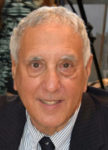
By Donald H. Harrison


SANTEE, California – Located at 10144 Mission Gorge Road in Santee, within walking distance of the trolley stop, and between State Routes 67 and 125, what will become the County of San Diego’s new vital records center and wedding place is expected to open in November 2019 on land that the county government already owns. A $20 million, 25,000 square foot structure and parking lot will have enough solar panels to be self-sufficient in electricity, and will put into practice various environmental recommendations necessary to be awarded LEED gold status.
That was the message disseminated by a phalanx of county and Santee City officials, who participated in a ceremonial groundbreaking on Wednesday, Oct. 24, that featured Ernest Dronenburg, who holds the three consolidated County offices of Recorder, Clerk, and Tax Assessor; Dan McAllister, the County Treasurer; and John Minto, the Mayor of Santee.
Dronenburg said the County will archive original documents at this new facility, which will be temperature- and humidity-controlled to guarantee their survival. With historic records dating back to the mid-19th Century now stored at various locales throughout San Diego County, Dronenburg said his office decided to consolidate them all in one place that was both accessible to the public and environmentally state-of-the-art. The center will be a boon for historians who are interested in local history or the history of their own families.
From the standpoint of local history, Dronenburg cited a document in the possession of his office that is signed by President Abraham Lincoln and which conveys back to the Catholic Church the property at Mission San Luis Rey, which had been expropriated by the Mexican government and which became U.S. government property after the Treaty of Guadalupe Hidalgo in which California and other Mexican territories were ceded to the United States.
Mayor Minto spoke of the family history component, telling the audience at the groundbreaking site that Joseph Coyne, the great-grandfather of his wife, Laura McGowan Minto, had been both the sheriff of San Diego County and later, in 1889, police chief for the City of San Diego. He said that his family has been looking up records to learn more about Coyne, and will appreciate the original documents all being stored in a central location.
Jewish history in San Diego dates back to 1850, the year California became a state and the City of San Diego was incorporated. Records of Jews who married and died in the county will be stored along with those of residents of other faiths.
Currently Dronenburg’s office employs 25 people at another East San Diego County facility, but once the new building is constructed, the workforce will double from 25 to 50 people, Dronenburg said. Among the employees will be a trained archivist, schooled in the science of preserving historic documents. He said that some county maps have become so old that they are beginning to deteriorate, even emitting a smell that could be toxic. He said that the new facility will prevent deterioration of other documents.
Besides archiving history, the new center in Santee also may become a place where history is made. Dronenburg’s office issued approximately 25,000 marriage licenses last year, and officiated at 17,000 weddings at its offices throughout the county, including nearby El Cajon. He said about 1,000 weddings were conducted in East County last year, and predicted that number could double after the new building, with a wedding arbor, is constructed.
In addition to the Recorder’s Office, where people may obtain birth records, marriage licenses, death certificates, and view old maps, the new facility also will include a branch of the County Treasurer’s office, to which local residents pay their property tax bills. McAllister said having a branch office in Santee will provide residents of San Diego’s sprawling East County with better, more convenient service.
*
Harrison is editor of San Diego Jewish World. He may be contacted via donald.harrison@sdjewishworld.com